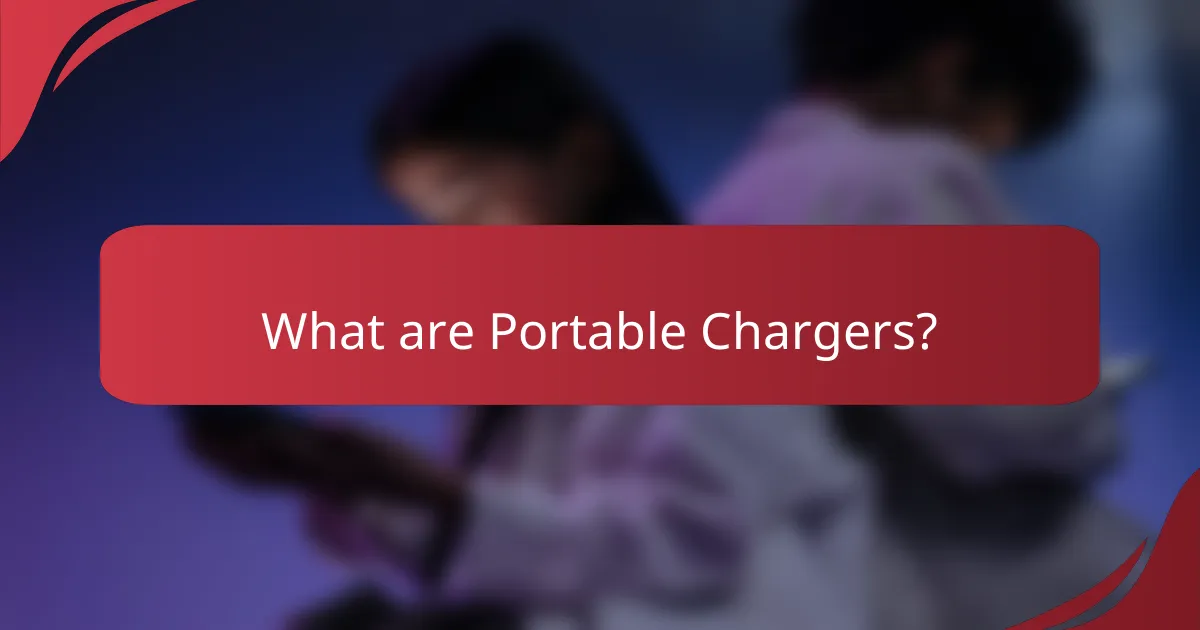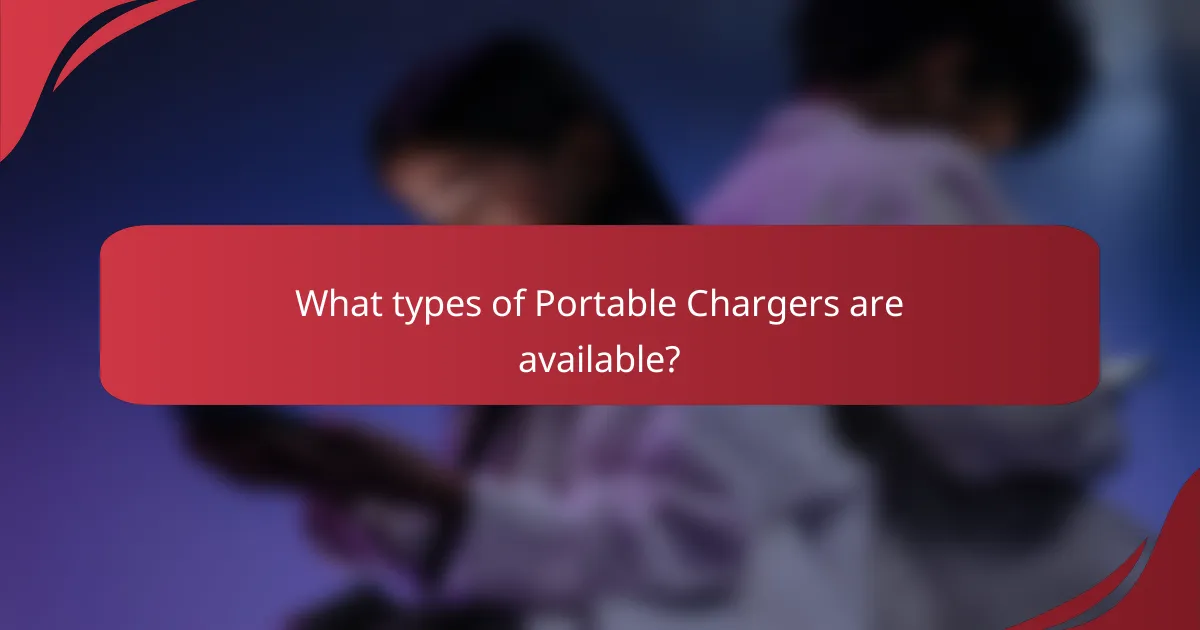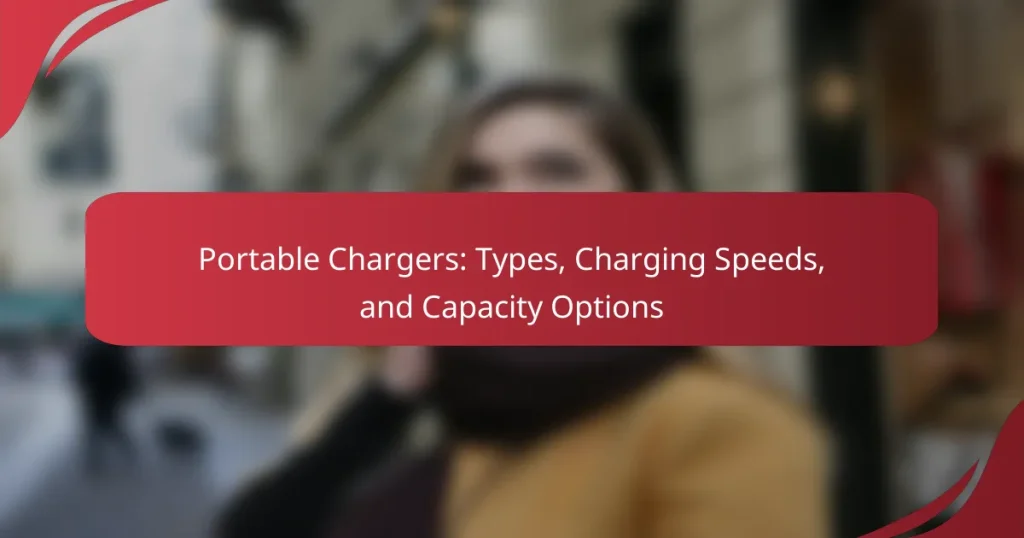Portable chargers are external battery packs that recharge electronic devices through USB connections, with capacities ranging from 2,000 mAh to 30,000 mAh. This article explores the various types of portable chargers, including power banks, solar chargers, car chargers, and wireless chargers, each offering distinct advantages for different charging scenarios. It also examines the factors influencing charging speeds, such as output power ratings, charging technologies like Quick Charge and Power Delivery, and the quality of charging cables. The growing demand for portable chargers reflects their importance for maintaining device usability during travel and outdoor activities.

What are Portable Chargers?
Portable chargers are external battery packs designed to recharge electronic devices on the go. They typically connect to devices via USB ports. Portable chargers come in various capacities, measured in milliampere-hours (mAh). Common capacities range from 2,000 mAh to 30,000 mAh. Higher capacities allow for multiple charges of a smartphone or tablet. Many portable chargers also feature multiple output ports for charging several devices simultaneously. They are essential for maintaining device usability during travel or outdoor activities. The global portable charger market is projected to grow significantly, reflecting their increasing demand.
How do Portable Chargers function?
Portable chargers function by storing electrical energy in a rechargeable battery. They convert this stored energy into a usable form for electronic devices. When connected to a device via a charging cable, the charger transfers power from its battery to the device’s battery. Most portable chargers use lithium-ion or lithium-polymer batteries, which are efficient and lightweight. The output voltage and current are regulated to match the requirements of the device being charged. This ensures safe and effective charging. Many portable chargers also feature multiple output ports, allowing simultaneous charging of multiple devices.
What are the key components of a Portable Charger?
The key components of a portable charger include the battery, charging ports, and circuitry. The battery stores electrical energy, typically lithium-ion or lithium-polymer. Charging ports allow devices to connect for power transfer. Circuitry manages the flow of electricity and ensures safe charging. Additionally, some models include LED indicators to show battery level. These components work together to provide portable power solutions for various devices.
How do these components impact charging efficiency?
Charging efficiency is significantly influenced by components such as battery chemistry, circuit design, and connector type. Battery chemistry, like lithium-ion, offers high energy density and low self-discharge rates, enhancing efficiency. Circuit design determines how effectively power is transferred from the charger to the device. Efficient circuits minimize energy loss as heat during charging. Connector type affects compatibility and resistance; high-quality connectors reduce power loss. Additionally, features like fast charging technology optimize the power delivery process. Studies show that optimized components can improve charging efficiency by up to 30%.
What are the advantages of using Portable Chargers?
Portable chargers provide convenience for charging devices on the go. They allow users to recharge smartphones, tablets, and other electronics without needing a wall outlet. This portability is essential for travel, outdoor activities, and emergencies. Many portable chargers are lightweight and compact, making them easy to carry. They often come with multiple charging ports, enabling simultaneous charging of multiple devices. Additionally, portable chargers can have high capacity, providing several full charges for devices. Some models support fast charging, reducing downtime for users. Overall, portable chargers enhance device usability and accessibility in various situations.
How do Portable Chargers enhance mobility?
Portable chargers enhance mobility by providing a reliable source of power for devices on the go. They allow users to charge smartphones, tablets, and other electronic devices without needing to find a wall outlet. This convenience is essential during travel, outdoor activities, or long commutes. Portable chargers come in various capacities, often ranging from 5,000 mAh to 20,000 mAh. Their lightweight and compact designs make them easy to carry in bags or pockets. According to a survey by Statista, 59% of smartphone users consider battery life a crucial factor in their device choice, highlighting the importance of portable charging solutions. By ensuring devices remain powered, portable chargers significantly improve users’ ability to stay connected and productive while away from traditional power sources.
What are the environmental benefits of Portable Chargers?
Portable chargers offer significant environmental benefits by reducing electronic waste and promoting energy efficiency. They allow users to charge devices on-the-go, decreasing the need for multiple chargers and reducing the overall carbon footprint. By facilitating the use of renewable energy sources, such as solar-powered portable chargers, they further contribute to sustainability. Studies show that using portable chargers can extend the lifespan of devices, thus minimizing waste. Additionally, they enable users to charge devices in locations where traditional power sources may not be available, reducing reliance on fossil fuels. This versatility supports a more sustainable lifestyle, aligning with global efforts to combat climate change.

What types of Portable Chargers are available?
There are several types of portable chargers available. The most common types include power banks, solar chargers, and car chargers. Power banks are battery packs that store energy for charging devices on the go. Solar chargers harness sunlight to charge devices, making them eco-friendly. Car chargers plug into a vehicle’s power outlet to charge devices while driving. Additionally, wireless chargers allow for charging without cables, using electromagnetic fields. Each type offers unique benefits for different charging needs. Power banks typically come with various capacities, ranging from 2,000 mAh to over 30,000 mAh. Solar chargers may vary in efficiency, depending on sunlight exposure. Car chargers often provide quick charging options for convenience. Wireless chargers are compatible with devices that support Qi technology. These types cover a wide range of user preferences and usage scenarios.
How do different types of Portable Chargers compare?
Different types of portable chargers compare based on their capacity, charging speed, and form factor. Capacity is measured in milliamp hours (mAh), with options ranging from small 2,000 mAh chargers to larger 20,000 mAh models. Charging speed varies, with some chargers offering fast charging capabilities, often rated at 18W or higher, while others may provide standard 5V/1A output. Form factors include slim, pocket-sized designs and bulkier models that can charge multiple devices simultaneously. Additionally, some chargers feature built-in cables or wireless charging options, enhancing convenience. Each type serves different user needs, from casual phone users to heavy device users.
What are the differences between power banks and solar chargers?
Power banks store electrical energy for later use, while solar chargers convert sunlight into electrical energy. Power banks are typically charged via an electrical outlet. They provide a portable power source for devices like smartphones and tablets. Solar chargers rely on solar panels to generate electricity. They can charge devices directly from sunlight or store energy in a built-in battery. Power banks are generally faster for charging due to direct electrical input. Solar chargers depend on sunlight availability, which can be inconsistent. Power banks have a fixed capacity measured in milliampere-hours (mAh). Solar chargers often have variable output based on sunlight conditions.
What features distinguish wireless chargers from wired chargers?
Wireless chargers use electromagnetic fields to transfer energy, while wired chargers rely on direct electrical connections. Wireless charging provides convenience by eliminating the need for cables. It allows for charging through cases and without precise alignment. However, wireless chargers typically have slower charging speeds compared to wired options. Most wireless chargers offer a maximum output of 15 watts, while wired chargers can reach up to 100 watts or more. Additionally, wireless chargers may generate more heat during operation, which can affect efficiency. Wired chargers often have a more stable connection, resulting in consistent power delivery.
What are the best uses for each type of Portable Charger?
Power banks are versatile portable chargers designed for various uses. They are ideal for charging smartphones during travel or outdoor activities. Ultra-compact chargers are best for daily commutes and short trips. They fit easily in pockets or small bags. High-capacity power banks suit long trips or multiple device charges. They can charge tablets and laptops as well. Solar chargers are perfect for camping or hiking. They harness sunlight for charging in remote areas. Wireless chargers are convenient for quick top-ups without cables. They are suitable for home or office use. Fast chargers are optimal for users needing quick power boosts. They reduce downtime for devices significantly. Each type of portable charger serves specific needs, enhancing convenience and mobility.
Which type of Portable Charger is ideal for travel?
The ideal type of portable charger for travel is a compact power bank with a high capacity. These chargers typically have a capacity of 10,000 mAh or more. This capacity allows for multiple device charges without needing to recharge the power bank itself. Furthermore, lightweight models are preferable for ease of transport. Fast charging capabilities are also essential, allowing devices to charge quickly during short stops. USB-C output is beneficial for compatibility with various devices. Additionally, chargers with multiple ports enable simultaneous charging of multiple devices. These features ensure convenience and efficiency while traveling.
What type of Portable Charger is best for emergency situations?
A portable charger with a high capacity and fast charging capability is best for emergency situations. These chargers typically have a capacity of 20,000 mAh or more. This allows them to charge multiple devices multiple times. Fast charging technology, such as Quick Charge or Power Delivery, ensures rapid power restoration. Additionally, a compact and lightweight design is crucial for portability. Many emergency portable chargers also feature multiple output ports. This enables charging of several devices at once. Reliable brands often include built-in safety features to prevent overheating and overcharging. These characteristics make them ideal for urgent power needs.

What factors affect the charging speed of Portable Chargers?
The charging speed of portable chargers is influenced by several key factors. These include the output power rating, which is typically measured in watts. Higher wattage allows for faster charging. The type of charging technology also plays a role. Technologies like Quick Charge or Power Delivery enable quicker charging times. The capacity of the power bank, measured in milliamp hours (mAh), affects how long it can deliver power. The cable used for charging is another factor; a high-quality cable can support faster data transfer. Lastly, the device being charged impacts speed. Different devices have varying power intake limits, which can slow down the charging process.
How does charging speed vary between different models?
Charging speed varies significantly between different models of portable chargers. Factors affecting this include output wattage, battery technology, and charging protocols. For instance, some models offer fast charging capabilities of up to 45W, while others may only provide 10W. High-capacity chargers often support multiple devices with varying speeds. Additionally, chargers utilizing Quick Charge or Power Delivery technologies can recharge devices much faster than standard USB outputs. For example, a charger with Power Delivery can charge compatible devices to 50% in just 30 minutes. Overall, the charging speed is determined by the specific features and technologies integrated into each model.
What role does output power play in charging speed?
Output power directly influences charging speed. Higher output power allows devices to draw more energy in less time. For example, a charger with 18W output can charge a compatible device significantly faster than a 5W charger. This is due to the increased voltage and current supplied. Many modern devices are designed to take advantage of higher output power. They utilize fast charging protocols to optimize energy transfer. Research indicates that charging speed can improve by up to 70% with higher output power. Therefore, output power is a critical factor in determining how quickly a device can be charged.
How do charging protocols influence speed?
Charging protocols significantly influence charging speed by determining how power is delivered to a device. Different protocols, such as Quick Charge or Power Delivery, manage voltage and current levels during charging. For instance, Quick Charge can increase voltage to 12V, allowing faster charging than standard 5V USB.
Power Delivery supports higher wattages, enabling devices to charge up to 100W. This results in reduced charging times for compatible devices. Moreover, the negotiation process between the charger and device establishes optimal charging conditions.
Studies show that using a compatible fast charger can reduce charging time by up to 70% compared to standard chargers. Therefore, the choice of charging protocol directly affects how quickly a device can be charged.
What capacity options are available for Portable Chargers?
Portable chargers are available in various capacity options, typically ranging from 2,000 mAh to 30,000 mAh. Smaller capacity chargers, like 2,000 to 5,000 mAh, are portable and suitable for emergency charges. Medium capacity options, such as 10,000 to 15,000 mAh, provide multiple charges for smartphones. High-capacity chargers, exceeding 20,000 mAh, can power tablets and laptops. Each capacity option caters to different user needs, balancing portability and charging capability. The choice depends on the devices being charged and the duration of use.
What is the significance of mAh rating in Portable Chargers?
The mAh rating in portable chargers indicates the battery capacity. It represents the amount of energy the charger can store and deliver. A higher mAh rating means more power available for charging devices. For example, a 10,000 mAh charger can typically charge a smartphone two to three times. This rating helps consumers choose chargers based on their needs. Understanding mAh ratings allows users to select chargers that match their device’s battery capacity. Therefore, the mAh rating is crucial for estimating how many times a charger can recharge a device.
How does capacity affect the number of charges a device can receive?
The capacity of a portable charger directly affects the number of charges it can provide to a device. Capacity is measured in milliampere-hours (mAh). A higher mAh rating means the charger can store more energy. For example, a 10,000 mAh charger can typically charge a smartphone with a 3,000 mAh battery about three times. This is because the total energy available is divided by the energy required to fully charge the device. Therefore, capacity determines how many complete charges can be delivered before the charger needs to be recharged itself.
What are practical tips for choosing the right Portable Charger?
To choose the right portable charger, consider its capacity, compatibility, and charging speed. Capacity is measured in milliampere-hours (mAh). Higher mAh ratings provide more charges for devices. Compatibility with your devices is crucial. Ensure the charger supports your device’s voltage and connector type. Charging speed is determined by the output amperage. A higher amperage results in faster charging. Look for features like multiple ports for charging several devices simultaneously. Additionally, consider the charger’s size and weight for portability. Research shows that chargers with built-in safety features protect devices from overheating and overcharging.
Portable chargers are external battery packs designed to recharge electronic devices on the go, with capacities ranging from 2,000 mAh to 30,000 mAh. This article explores the functionality, key components, and advantages of portable chargers, including their impact on mobility and environmental benefits. It also compares different types, such as power banks and solar chargers, and discusses factors affecting charging speed, including output power and charging protocols. Additionally, the significance of mAh ratings and practical tips for selecting the right portable charger are provided, ensuring users can make informed decisions based on their charging needs.


